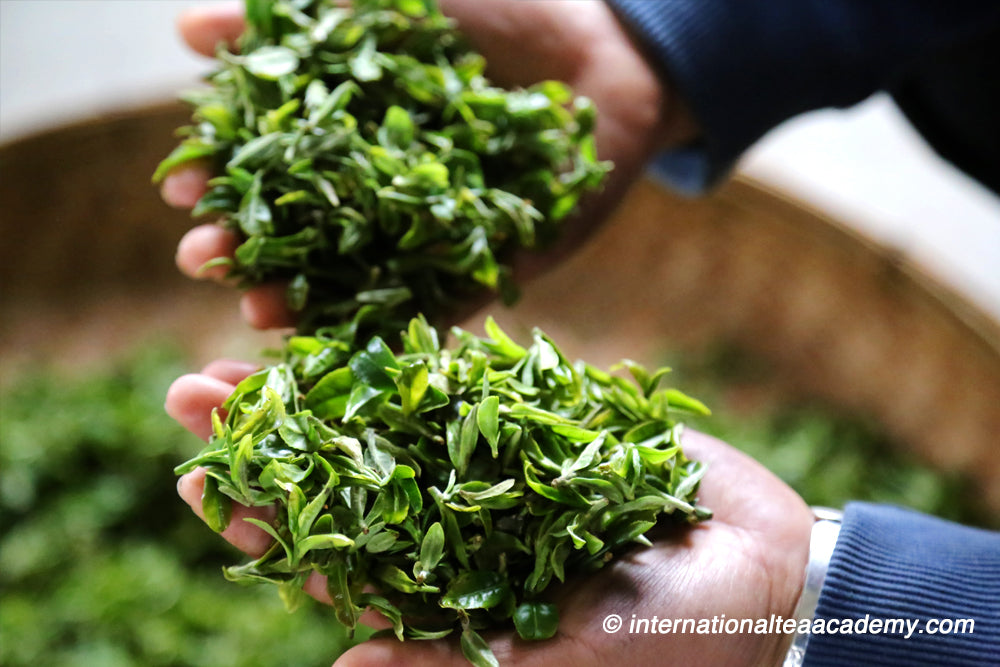
If you’re reading this part, you might laugh out loud. Who doesn’t know what tea is! Everybody in the world knows about tea and how to drink it, right? Who am I to give an authoritative definition of tea?
Yes, it’s true, most people in this world have drunk tea. Even a kid knows what tea is. As a native Chinese person, especially one with a family that honors traditional culture, I saw that on one hand, tea is very well known throughout the world. On the other hand, hardly anyone has even scratched the surface of tea’s deeper meaning, even lots of Chinese people.
What is the definition of tea in your mind? A leaf? A beverage? A medicine? Yes, each of these is true and right. When I define tea, I like to use both Eastern and Western thinking.
Since Western science has become very popular, people prefer to use that method of logic when thinking about things. Here’s an example:
The “logical” way of understanding something is to “kill” it, then dissect it so you can understand each individual piece in isolation, and then put it all back together and see how each individual piece works together in a system. By following this process, we try to rebuild the life which had already been there before we came along. Let’s take a specific topic to explain in more detail:
In traditional Chinese medical science, meridian acupuncture is a well-known therapy. For thousands of years, acupuncture was the mainstay meridian therapy for healing and energy balancing in the East. Martial arts such as tai chi (chi is also commonly known as Qi (Chi) and chi (Qi) gong evolved as practices and energy exercises that move Qi (Chi) through the meridians and the body's energy system. The theory has been used for wellness for thousands of years in the East.
The range of applications for acupuncture has grown slowly in the West, possibly because of the belief that it has no scientific basis. But interestingly, in 2016, scientists confirmed that meridians exist in our bodies:
“The Korean scientists studying oriental medicine with biophysical methods injected a special staining dye which colored the meridians. By injecting the dye onto acupuncture points, they were able to see thin lines. These did not show up at non-acupuncture point sites where there are no meridians. The researchers discovered that the meridian lines are not confined to the skin, but are in fact a concrete duct system through which liquid flows, and that this liquid aggregates to form stem cells."
“Previously, scientists used a combination of imaging techniques and CT scans to observe concentrated points of microvascular structures that clearly correspond to the map of acupuncture points created by Chinese energy practitioners in ancient times. In a study published in the Journal of Electron Spectroscopy and Related Phenomena, researchers used contrast CT imaging with radiation on both non-acupuncture points and acupuncture points. The CT scans revealed clear distinctions between the non-acupuncture point and acupuncture point anatomical structures.”
So this brings up a question: how could ancient Chinese people know meridians exist in our body without the high technology available in modern times?
As a traditional Chinese person myself, I think this question is actually very easy to answer: as I described above, the Western “logical” way of understanding something is to “kill” it (or to see inside it), so they need to dissect or get inside a thing, break it into pieces, understanding it piece by piece, then recombine everything to construct anew something that already once was.
But in the Eastern world, a different way of thinking prevails: Feeling things in their entirety is more important than cutting it up to observe the parts in isolation. We especially want the thing we’re trying to know live as it is so that we can feel it in its entirety. We don’t use external force to touch it or interfere with it. By following this principle, we can actually get more comprehensive information about the things we’re trying to understand.
So back to the original question: What is tea?
Tea is not just a thing you can drink or do business with. At its most profound level, tea is a way of thinking. It’s a way to help you feel things you want to understand, and it will help you understand things much deeper and more directly without the need to first destroy it. And it will teach you that just seeing a thing is not sufficient to understand it correctly. It will teach you how to feel the things you want to understand by directly perceiving the entirety of the thing. From this perspective, you’ll see things from a different angle and will feel things in a new way, but also more comprehensively.
For more informations. Please check
• ITA Certified Tea Sommelier Training
• ITA Certified Online Tea Courses
• ITA Tea Books
@ All copy right reserved by Wild Tea Qi & International Tea Academy
Comments will be approved before showing up.